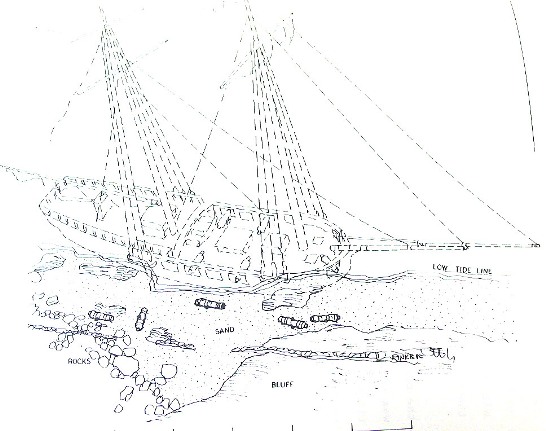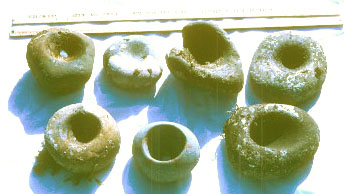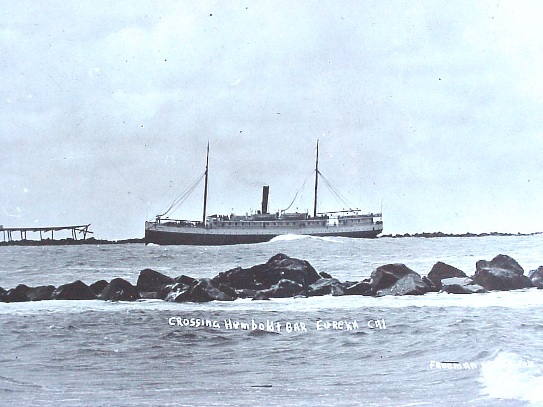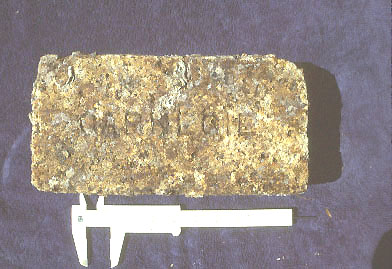
ARCHAEOLOGY AND HISTORY BENEATH THE SEA:
THE PRESERVATION, MANAGEMENT AND
INTERPRETATION OF CALIFORNIA'S HERITAGE RESOURCES
John W. Foster
Senior State Archaeologist (Retired)
California State Parks
Introduction
California is blessed with many natural splendors. Of the contiguous states, it has the highest peak, the lowest valley, the largest fault system, the oldest and largest trees, and the greatest number of plant and animal species in North America. Its historical superlatives are no less dramatic. Aboriginal California was home to more than 300,000 people, a greater number than any comparable area north of Mesoamerica (Moratto 1985). It also has a very rich and varied maritime history. What connects California to the World Ocean more than its history? California, a land of legend and mystery, was explored, colonized and described by sea. Thus it's only fitting that we take active steps to understand and manage these maritime heritage sites as part of our legacy from the past.
The purpose of this paper is to briefly outline three past examples of what could be done with different submerged cultural resources. They are not necessarily California's best examples of what has been done, but rather shows a slow progression of what is being done to better understand maritime heritage resources. I want to conclude with a proposal for a "California Shipwreck Trail, that has been shamelessly lifted from one in the Florida Keys. Now that they have done theirs, we can learn from it and do it better. So lets take a quick maritime tour.
The Sterling
In the summer of 1984 a magnetometer survey was performed along the Sacramento waterfront. Many of the anomalies that were identified had no archaeological significance, but one dramatic feature was discovered. Protruding from the bottom silts at a depth of 30 feet, lay the remains of a blue-water sailing ship. About 30 feet of the bow section was exposed, with the remainder covered by riprap rock that armors the floodwall in that vicinity. The cutwater was clearly visible as were bar-style chain plates and other ship debris (Foster 1988:100).The vessel's hull is sheathed with copper plates, attesting to its oceanic heritage and mid-19th century age. Exiting from the starboard hawsehole is a stud-linked chain, showing the vessel was anchored at the time of her loss.Detailed surveys identified many artifacts at the site. These included an Admiralty-style anchor, which when cleaned, revealed an "1844" date scribed in the crown. Other items included a China doll's head and frying pan.
One of the more astounding aspects of this site is that it contains a second shipwreck on top of the first. The burnt hull remains of a flat-bottom river craft lie perpendicular to the sailing ship and parallel to the floodwall. The heavy timbers are fastened with iron. This is almost certainly a victim of the great Broderick fire that swept the Sacramento waterfront in 1932, consuming dozens of steamers and barges laid up by the depression.

Figure 1. This sketch of the Sacramento waterfront by G.V. Cooper in Dec.,1849 shows a small vessel at the foot of J Street. This is probably the Sterling, which sank in 1855.
The Sterling was built in Duxbury, Massachusetts in 1833 by Samuel A. Fraser. Eighty eight feet in length, 2 masted and registered at 201 tons, she plied the coastal trade between Boston and Philadelphia in the 1840's (Delgado 1985). But she was fated to join the California '49er Fleet, and departed Beverly, Mass. for San Francisco on January 3, 1849. She arrived after 180 days and made her way up to Sacramento. Her remaining days were passed stripped of her sails and rigging, converted to a storeship, at various places along the Sacramento levee before finally sinking at her moorings in the fall of 1855.

Figure 2. Archaeological surveys have documented the hull of a gold-rush shipwreck that sank near the foot of J Street in the Sacramento River. It is partially covered by a burnt riverboat hull. Drawing by Nicholas Del Cioppo and John W. Foster.
All these events might have passed unnoticed among the other abandoned sailing vessels lining the Sacramento waterfront, except that Sterling's bones became encased in the mud at the foot of J Street. The City engaged a contractor to remove the obstacle. Over the next several months there were no less than 8 items concerning the Sterling's fate which appeared in the Democratic State Journal. Pumps and gunpowder could not remove Sterling from her grave and the effort was abandoned. In a final lament that they would no longer be able to fill up their columns with progress reports on the Sterling, a eulogy appeared:
Though other ships may come
and other bards may sing,
Strange matters oft transpire
Here's health to thee STERLING!
Here's a hand for those who love thee--
Here's a smile for those who hate,
A sigh for those who don't deplore,
Thy twisted watery fate!
Great scarcity of items
May make reporters sulk
But when we have our columns full
We'll drink to thee, "Old Hulk."
Democratic State Journal, Nov. 1, 1855
Sterling's remains as well as the timbers of the riverboat are still in place at the foot of J Street. They lie within the National Register District of Old Sacramento. The time may come when it is useful to excavate the ship or perhaps protect and interpret it in place as a time capsule of the gold rush. It would make an impressive in-situ display. Protected by sheet pilings and in clear water, people could see an actual vessel of the '49er fleet -- in the heart of the historic district.
Goleta Cannon Site
A fierce three-day winter storm in January of 1981 sent huge waves crashing on the shore of Goleta. The swells removed a large part of the beach sand, exposing the sandstone bedrock. It was along this shore that Nolen Harter of Carpenteria went beachcombing. At the base of the cliff a few hundred meters from the Goleta pier, he found five iron cannons encased in concretions of sand and rock. The objects were reported to UCSB, and a day later the phone in my office rang with reports of the find.
Our next several years were spent engaged in the resolution of the question: how and when did five iron cannons make their way to Goleta? In the process, we identified a maritime site of major significance and antiquity.
The first order of business was to determine what was inside the concretions. Since one was thought to be too fragile to move, the remaining four were taken to the US Naval Weapons Center at Concord, California for x-ray. There the world's largest x-ray machine, accustomed to use on aircraft parts and secret military equipment, produced outstanding images of the cannons. They were muzzle loaders, some four feet long, approximately six-pounders in bore size, and had "low-set" trunion placement on the bore line. The features could be clearly seen and when compared, showed each cannon to have individual attributes. All were well preserved.
Cleaning and electrolytic conservation of the cannons were carried out at UCSB. The only diagnostic markings present were an "87" embossed on one trunion and an "H" on the opposite one. In general style, they resembled English guns of Napoleonic age, but comparable dated examples proved difficult to find. Metallurgy was done on the iron and, based on sulfur content, hinted at an earlier date.
A local writer and historian, Jim Gilmore, conducted an extensive comparative study. To the surprise of many, he discovered that although most experts assumed them to be late 17th or early 18th century in age, there were iron cannons of comparable shape and dimension as early as the 16th century (Gilmore and Hunter 1983:70-91). These included the Bideford guns (late 16th century) and the armament of the Batavia, which sank in 1629. Gilmore and Hunter concluded that iron cannon design changed little between Elizabethan times and the 17th century.
Cannon weights proved to be an important clue as to age, according to Gilmore and Hunter. The Goleta cannons weighed just over 700 pounds. They probably fired shot with a 3 in. diameter weighing 4- 4 1/2 pounds. Using gun/shot weight ratios, the Goleta examples are more similar to 16th century ratios than those from succeeding centuries. As gunpowder became more explosive, iron cannons grew thicker and heavier.
Gilmore concluded that Francis Drake could have left the cannons when he visited the coast of California in the summer of 1579. He proposed that the Golden Hind was careened in the shallow bay of that time and perhaps the cannons had been positioned on top of the bluff to guard its entrance. Then they were abandoned, and subsequent erosion and cliff retreat brought them to their discovery site some 400 years later (Gilmore 1981). This caused a storm of controversy, and led to the analysis Goleta as a possible Drake landing site (Foster 1982; Foster, Hunter and Gilmore 1984).

Figure 3. The Dorotea may have grounded at the entrance to the Goleta Slough but there is no evidence she deposited cannons there. (From Ruhge, 1982)
An alternative theory was proposed by amateur historian, Justin Ruhge. He presented an account of the shipwreck activity at the entrance to the Goleta slough and noted several vessels had grounded there, including the Dorotea in 1829 or 1830 (1992:59). However, there was no evidence that she lost her cannons there, She was refloated and is reported in San Blas in 1834. Existing historical accounts do not solve the mystery, but the Goleta cannons are preserved and available for active interpretation.
In an attempt to locate any other shipwreck remains at the Goleta cannon site, several surveys were conducted. Using a terrestrial magnetometer, a cursory survey was performed of exposed areas inside the slough. This effort located some iron debris of uncertain age, but failed to reveal any shipwreck. An offshore magnetometer and diving survey was more productive. While all of the anomalies, could be explained by 1920s oil derek debris, the SCUBA surveys located a series of stone bowls off the mouth of Goleta Slough.

Figure 4. Seven stone bowls recovered offshore from Goleta Beach. They were common household items in coastal Chumash villages between 1200 BC and AD 1100.
A total of seven bowls were documented. An analysis revealed that they were typical of middle period (1200 BC to AD 1100) specimens from elsewhere along the Santa Barbara channel (Foster and Hunter 1998). A previous bowl had been documented from the vicinity by Hudson (1976). Whether the concentration of bowls is due to coastal outwash, the presence of a submerged coastal village, or bluff erosion has not been determined, but there seems to be a wealth of artifacts off Goleta beach, making it an important maritime heritage location. Through future research, it may be possible to discover the source of the guns and to document the ancient use of this area.
SS Pomona
St. Patrick’s Day, 1908, was a typical brisk spring afternoon on the north coast of California. A rising wind swept the sea from the northwest, and a large swell was running. There was an uncomfortable chop caused by wind waves and whitecaps. It was into this sea that Capt. Swansen cleared Pt. Bonita from the Pacific Coast Steamship Company docks in San Francisco, and set course for Eureka. He stood at the helm of the Steamship Pomona. His vessel had made this run many times, but he could not have suspected that the great ship, known as the “Pride of the Coaster Fleet,” would never again cross the Humboldt bar. Its 147 passengers and crew were about to become witness to maritime history and underwater archaeology

Figure 5. SS Pomona crosses the Humboldt Bar. The "Pride of the Coaster Fleet" was wrecked at Ft. Ross on March 17, 1908. Photo courtesy of the San Francisco Maritime Museum.
White water was everywhere on the horizon and no boil or breaker gave clue to the hidden rocks ahead. One passenger later reported the ship was so close in that, “You could see the color of a cow on the hillside.” Shortly after 6pm the ship lurched violently as she struck an uncharted pinnacle two miles south of Ft. Ross reef. Perhaps this was a rock thrust up by the recent earthquake, later reports would say. The crew immediately assessed damage. Although the ship was free of the reef, a gaping hole had been punched in the steel hull. The pumps were called to prevent the ship’s loss. Capt. Swansen, a veteran of many years sailing the redwood coast, calmly decided his only course of action was to beach the vessel in Ft. Ross cove to save her. He ordered full steam and maximum effort on the pumps. The steamer gave her best. She reached a speed of 13.2 knots as frightened passengers gathered their belongings.
As she approached the fort, the great ship foundered. She was down by the bow with six feet of water in the hold. The helm was sluggish and unresponsive. In desperation, Capt. Swansen steered into the cove, but a wash rock loomed dead ahead. Passengers and crew braced for the impact. Within seconds, the rock dealt a fatal blow to the great ship. She rode up over the top on her keel, only to become impaled through the hull and held fast in the swirling sea -- a victim of a “stern and rock-bound coast.” She slowly twisted her bow to face the sea as she settled ever lower in the water
Initial salvage efforts of the SS Pomona were soon commenced. The Coast Wrecking Company purchased rights to the wreck and began work. The plan was to remove most of the cargo and refloat the vessel by inflating canvas bags throughout the hull. Then the ship could be towed back to San Francisco to dry dock for repairs.
This hardhat diving was begun in earnest, but not without its dangers, as reported by the San Francisco Chronicle (Sept. 28, 1908):
Diver Fights With Octopus
“Martin Lund, a diver for the Pacific Coast Wrecking Company, had a terrible experience with a monster devil fish while he was in seven fathoms of water Saturday afternoon at Fort Ross cove, working on the Pomona, which was wrecked some months ago. Lund was in the hold of the wrecked vessel, when he was seized about the leg by the tentacle of a devilfish. He slashed at the fish with his knife and gave the signal to be hoisted. The devil-fish had too strong a hold on him, and he had to signal the helpers to ease their efforts to haul him to the surface because his helmet was giving way. Another tentacle grasped him about the waist, and still another about the neck. Then another grasped him about the legs and he had to fight hard for life. After cutting two of the tough tentacles that grasped him in a deathlike embrace, Lund saw the creature preparing to strike with its beak, and made a lunge for the head just in time to deal a death blow.”
It finally became apparent that the Pomona would never leave Ft. Ross cove. Her prop was salvaged, along with her triple expansion steam engine. Salvage master Capt. Whitelaw, using his steam schooner Greenwood, did the recovery. Many salvageable steam valves, pipes, fittings, tools and instruments were no doubt removed. Finally, she broke in two on Nov. 21st and slipped forever beneath the waves.
For the last two decades, a body of knowledge concerning the Pomona has accumulated from a series of studies. In 1981 the first systematic underwater survey conducted by State Parks took place at Ft. Ross cove. This was a combined effort using the Navy Diving Salvage Team, State Park divers, and many interested divers and supporters. It began with a magnetometer survey of most of both coves from shoal water to the 120-ft. contour and a SCUBA reconnaissance of all anomalies (Foster 1981). This effort brought us in contact with the Pomona’s remains for the first time. Although no systematic mapping was attempted, a brief record of the wreck elements was made. The drive train, boilers, forward hull and individual artifacts were noted and photographed. The overall condition and distribution of wreckage was documented (Foster:1984).

Figure 6. A connecting rod from the Pomona was left when the engine was salvaged. A significant amount of the ship has been documented including parts of its early triple-expansion steam engine.
New information on the Pomona shipwreck site accumulated slowly over the years. Using State Park divers and with the help of Jim Delgado, maritime historian from the National Park Service, incremental progress was made. The drive train details were documented and measured, but the rest of the vessel remained mysterious. A subsequent survey by Jack Hunter and his team were able to make some advances. A site record was completed and assigned the number SON-1704H, but the Pomona wreck site remained poorly defined (Hunter and Fisher 1989).

Figure 7. A "Carnegie" brick from the Pomona's firebox. This site is a popular SCUBA destination at Ft. Ross State Historic Park.
Under the direction of Charles Beeker from Indiana University, major advances in archaeology and history have been made since 1998. Working with students from Indiana as well as USD, CSU Northridge, San Jose State University and Sonoma State, an efficient collaboration made possible a great leap forward in the understanding of the site. Beeker's composite efforts resulted in a detailed site map being prepared, and an analysis of the shipwreck's remains were used to prepare drawings of the breakdown of the Pomona itself as she slowly broke her back on the wash rock (Beeker 1998). The site formation process was illustrated. This has brought to life, the watery history of Ft. Ross cove. A nomination package for National Register consideration is now nearing completion. It deserves recognition as one of the most significant and complete iron-hulled steamers of its type along the California coast (Beeker 2002).
A California Shipwreck Trail
Part of our charge in managing these sites is to find ways of involving the public in its stewardship and protection. Partnerships can promote the celebration of history and recreational enjoyment at these sites. A "Shipwreck Trail" is one way to do so. It would be done by the four agencies with significant responsibilities for California's submerged cultural resources: California State Parks, California State Lands Commission, National Park Service and the NOAA's National Marine Sanctuary Office.

A Shipwreck Trail is a thematic link, not an actual one, among submerged sites. It allows the agencies to emphasize stewardship and interpretation of the most appropriate sites. Development of a "Shipwreck trail" could intensify interpretation of selected maritime sites and involve local divers in their long-term management.
What type of site should be included? They should be significant. The National Register of Historic Places criteria are one measure of historic and scientific significance. This is, of course, the best known formal gauge of a property's heritage value. Other considerations might include: ship construction, type of wreck, site sensitivity, aesthetics, access and location, and environmental conditions. The whole concept might include shipwrecks as well as other submerged sites.
Recreational diving studies show wrecks to be extremely popular attractions. By voting with their "bubbles," the public has recognized intrinsic worth in them. Agencies should capitalize on this interest to develop partnerships and enhance preservation as well as interpretation. Dive clubs should be recruited to monitor impacts at the sites and check on buoys and interpretive materials. A partnership has developed at Ft. Ross and could work elsewhere.
As Marine Managed Areas are developed, efforts to include a cultural component and actively manage these sites as valuable heritage resources are an important consideration. California is a leader in the development of underwater parks. The "Shipwreck Trail" has the potential to expand our efforts in developing brochures, videos and active public stewardship in this category of heritage sites.
References Cited
Barry, W. James and John W. Foster
2002 California Underwater Parks and Reserves, Draft Plan. Ms. on file at California Department of Parks and Recreation, Sacramento.
Beeker, Charles D.
1998 SS Pomona 1888-1908. A Diver's Guide to the Historical Shipwreck. On file with the Department of Parks and Recreation, Sacramento.
2002 National Register of Historic Places Inventory -- Nomination Form: SS Pomona. On file with the Department of Parks and Recreation, Sacramento.
Delgado, James P.
1985 National Register of Historic Places Inventory -- Nomination Form: Brig Sterling. On file with the Office of Historic Preservation, Sacramento.
Foster, John W.
1981 Diving in Dogholes: the Prospects for Investigating Submerged Cultural Resources in Ft. Ross Cove. Paper presented at the Annual meeting of the Society for California Archaeology, San Diego.
1982 Could All the Experts Be wrong?: Observations on the Native Inhabitants and Environs of Nova Albion. Presented at the Annual Meeting of the Society for California Archaeology, Sacramento.
1984 "Schooners, Steamers and Spilled Cargo: A Preliminary Underwater Survey of Ft. Ross Cove, California." In: Underwater Archaeology: The Proceedings of the 13th Conference on Underwater Archaeology, Donald H. Keith, editor. pp. 86-94.
1998 Stone Bowls from Goleta. Paper presented at the annual meeting of the Society for California Archaeology, San Diego.
Foster, John W., JacK Hunter and Jim Gilmore
1983 “New Fire from Old Guns: A Description and Tentative Interpretation of Five Iron Cannon from Goleta, California.” Presented at the International Conference on Underwater Archaeology, Denver.
Gilmore, Jim
1981 The Mystery of Five Iron Cannons. Santa Barbara Magazine, Dec. 1, 1981.
Gilmore, Jim and Jack Hunter
1983 The Guns of Goleta: A Fact Book of Evidence to Date and a Proposal for Future Research. On file at California State Parks, Sacramento.
Hudson, Travis
1976 Marine Archaeology Along the Southern California Coast. Museum of Man Paper No. 10. San Diego.
Hunter, Jack and Franklin Fisher
1989 A Shipwreck Mapping and Recordation Reconnaissance of the Remains of the Steam Ship S.S. Pomona, Fort Ross State Historic Park, Sonoma County, California. MS on file with California State Parks, Sacramento.
Moratto, Michael J.
1985 The California Culture Area. The Masterkey 59 (2&3) 4-11.
Ruhge, Justin M
1982 The Historic Cannons of Goleta, In Search of a Pedigree. Goleta, California.
